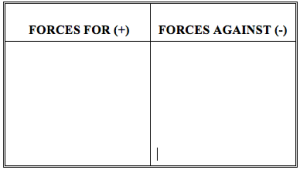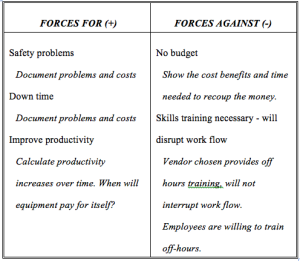“There are a number of competing groups within my organization. Sometimes a good idea can be squelched because the people who thought of and developed the idea did not consider its potential opposition. Is there a systematic process to deal with this type of potential problem?”
#5: Force Field Analysis
What is Force Field Analysis?
Force Field Analysis is a technique that involves identifying both the forces that support and the forces that resist a decision or change, and then determining how to strengthen the positive forces and weaken the negative forces so that the change can be implemented.
The forces you identify will likely include individuals or groups within your organization or industry, your customers, suppliers or any other stakeholder group. Forces will include tangible items such as budgets, physical restrictions and personnel, as well as intangible items such as politics, feelings and attitudes.
As any arm wrestler knows, when two competing forces work against each other, the force that is strongest and endures the longest is the force that wins. In the case of organizations, competing forces can be strong enough to kill even the best ideas.
When to Use Force Field Analysis
- When an idea is likely to face opposition
- When your group wants to test the pros and cons of a decision before presentation to upper management or other decision makers
- When you want to increase the likelihood that goals will be implemented
How to Use Force Field Analysis
- Explain the purpose of Force Field Analysis. You might say, for example, “We want to make sure that we are ready for both positive and negative responses to our decision (or suggestion for change). In order to best prepare ourselves, let’s take a few minutes to analyze the forces that will likely support our idea, as well as the forces that likely will not. We can then look for actions to build on the forces that support us, and actions to diminish the arguments against the change.”
- Draw a chart or display a pre-prepared chart similar to the one below and ask your group to brainstorm the ‘forces for’ and ‘forces against’ your proposed idea or change. Write the forces on the appropriate area of the chart.
NOTE: If it is unclear whether a force is for or against the proposal, put it aside on another sheet for later analysis.
NOTE: Leave enough space between the forces to brainstorm strategies in the next step, and use different colored pens to differentiate the two.
- After your lists are complete, brainstorm actions to strengthen the forces for your proposed change and actions to weaken the opposition to that change.
NOTE: It may be helpful to ask yourselves some questions about each force to help you with your brainstorming. You might ask, for example, “Who specifically is involved?” “What is the history of this?” “How do we know this actually exists?”
NOTE: Spend the most time focusing on the strongest forces on each side.
- After you have finished brainstorming the actions, have your meeting group select the most effective actions to strengthen the forces for and diminish the forces against. Refer to the example below for a completed, hypothetical example of a Force Field Analysis chart on the purchase of new equipment.
- Create action plans as necessary. Plan how to incorporate these plans into your presentation to management, or next steps towards implementation.
In Summary:
Force Field Analysis is a technique that involves identifying both the forces that support and the forces that resist a decision or change, and then determining how to strengthen the positive forces and weaken the negative forces so that the change can be implemented.
- Introduce and explain the purpose of Force Field Analysis.
- Ask the group to brainstorm forces for and forces against the proposal under consideration.
- After your lists are complete, brainstorm actions to strengthen the forces for your proposed change and actions to weaken the opposition to that change.
- After you have finished brainstorming the actions, have your group select the most effective ones to strengthen the forces for and diminish the forces against.
- Create action plans as necessary.
Source:
Kurt Lewin: Field Theory in Social Science. (Chicago: University of Chicago Press, 1951).
———————-
NOTE:
If you would like to receive e-mail notification when I post additional techniques, please sign up through this link. http://eepurl.com/KILan You may unsubscribe at any time.
You will find my book Mission Critical Meetings: 81 Practical Facilitation Techniques on Amazon. Your feedback and reviews are most welcome.

